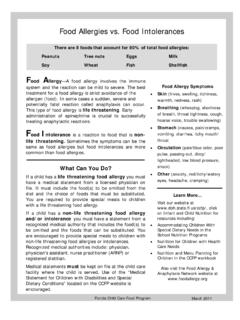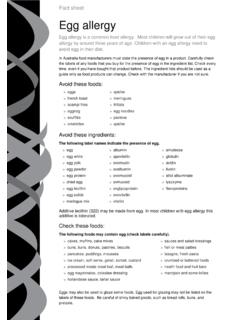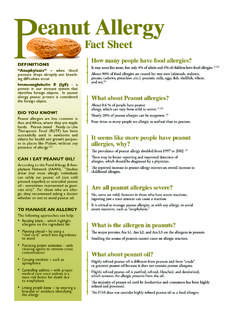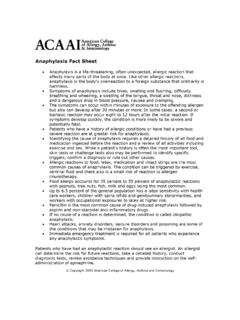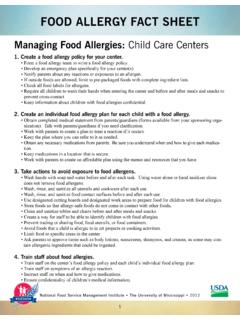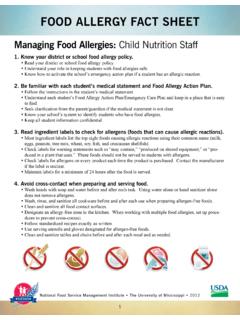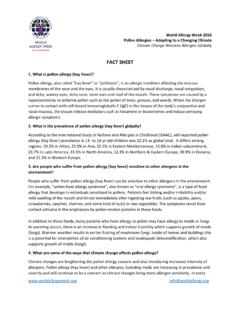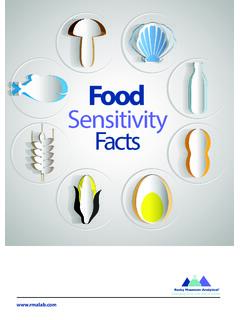Transcription of FAQ: Food Allergies, Intolerances & Celiac Disease
1 What is the difference between a food allergy , food intolerance and Celiac Disease ? True food allergies can be triggered by very small particles of the offending food , usually come on suddenly and can be life threatening. food allergies are the most common cause of anaphylaxis. food Intolerances are not life threatening, usually come on gradually and symptoms are dose related and may only happen if a lot of the food is eaten, or if the food is eaten often. Celiac Disease (also called gluten sensitive enteropathy ) is a hereditary autoimmune Disease that is triggered by the consumption of gluten, which is found in wheat, barley and rye. Unless certified , oats are not considered gluten free due to cross-contact. (See full list inside). When a person with Celiac Disease consumes gluten, it sets off an auto immune reaction that permanently damages villi in the small intestine, resulting in malabsorption of nutrients. Short term, a person with Celiac Disease can have symptoms such as migraines, fatigue, constipation, diarrhea, lactose intolerance, tooth decay and vomiting.
2 Long term, there is a dangerously high incidence of osteoporosis, infertility, thyroid disorders, neurological conditions (including depression), malnutrition and gastrointestinal cancer. With gluten intolerance (also called non Celiac gluten sensitivity ) there may be symptoms of discomfort and gastric distress due to an inflammatory response, but when gluten is removed, the inflammation subsides and the villi are not destroyed. Recently, non- Celiac gluten sensitivities have received international medical recognition as a legitimate medical condition. Dr. Alessio Fasano diagnosed gluten intolerance with accuracy in a recent double-blind, placebo controlled study. Those with gluten sensitivity lack the Celiac genetic marker characteristic and may experience the same symptoms without damage to the it okay to be less careful if the customer has just a food intolerance?No. The best practice for food service providers is to assume all food allergies or Intolerances are life threatening and follow proper procedures to avoid cross contact with offending food (s).
3 Staff should be trained to follow the same high level of precautions for all special diets, whether the cause is food allergy , intolerance, Celiac Disease or other medical a menu item is made in our regular kitchen without gluten containing ingredients can we identify it as gluten free ?Currently, the FDA is working on a legal definition of gluten free and certified gluten free. Still, it would be most accurate to say the item has no gluten containing ingredients . Some Celiac Disease sufferers are very sensitive and could have adverse reactions to even small particles of gluten in their food . For example: a separate toaster should be used for gluten free items, frying oil may retain gluten particles and a grill should be thoroughly cleaned before preparing gluten free foods. These precautions apply to food allergies as do we need to be careful with gluten, and why is cross-contact an issue? Celiac Disease occurs at varying degrees. Gluten affects those with Celiac and gluten sensitivity on a cellular level therefore, even something as small as a crumb of gluten can wreak havoc on someone with severe Celiac Disease .
4 The generally accepted standard to be considered Gluten Free is under 20 parts per million of gluten; this, visually, amounts to a spec smaller than the head of a pin. food Service professionals must wash their hands, change their gloves, use carefully cleaned utensils, and fresh, uncontaminated ingredients for all specially prepared meals whether it is for a food allergy , intolerance or Celiac every time. FAQ: food allergies , Intolerances & Celiac DiseaseMilk Egg Shellfish Fish Tree Nuts Wheat Peanut Soybean Which food allergens should be avoided when developing menu options?Typically food service establishments create menu options that avoid some or all of the eight most common allergens, which are: dairy, peanut, tree nuts (all), egg, soy, wheat, fish and shellfish. These eight foods cause 90% of all life threatening food allergy reactions. Many establishments also develop menu options without gluten. A list of gluten containing grains and gluten free grains are listed on the next page.
5 Here are a few examples of menu options that avoid all eight allergens and gluten: Turkey burger on a gluten free bun with baked sweet potato fries, quinoa and vegetable salad Roasted chicken with a baked potato and vegetable Rice noodle bowl with stir fried vegetables and chickenSome diners have food allergens not listed in the top eight most common or have multiple food allergies . Allergens that are less common but not rare are: garlic, cinnamon, beef, chicken, corn, sesame and sunflower. The most common allergens in the are not necessarily the most common in other oils considered allergenic?The food allergy Research & Education (FARE) website provides this explanation on their How to read a label for a soy free diet instructions: The FDA exempts highly refined soybean oil from being labeled as an allergen. Studies show most allergic individuals can safely eat soy oil that has been highly refined (not cold pressed, expeller pressed or extruded soybean oil).
6 There is a similar statement regarding peanut oil. Generally, allergic reactions to soy oil are mild and uncommon, but most individuals (especially those with a peanut or tree nut allergy ) would not risk using an oil from an allergenic food because the risk of a reaction is too dangerous. Top food Service Handling Mistakes: Not changing gloves and washing hands and failing to use separate utensils or fresh ingredients Using the same cooking surface without proper cleaning (grill, broiler) Not clearly marking ingredients or containers Not properly researching ingredient statements; Most notably gluten is not on the FDA s top allergens list, and therefore is not required to be labeled Not realizing that dust from allergens can remain on surfaces and contaminate allergen safe foodsWARNINGMilk Egg Shellfish Fish Tree Nuts Wheat Peanut Soybean What are the grains that DO Contain GLUTEN? Barley Graham Farina Bulgur (cracked wheat) Kamut Rye Einkorn Emmer Spelt Farro Triticale Oats (if not certified gluten free)Wheat is also known as: couscous, durum, semolina, and wheat berries What are the grains that DO NOT contain GLUTEN?
7 (When nothing else is added and processed in a facility that does not also process glutinous grains) Amaranth Oats (ONLY when certified as gluten free) Buckwheat Quinoa Corn Rice (any kind) Millet Tapioca Teff (Ethiopian grain similar to millet)Are there any other thickeners besides rice and tapioca flour that would work as a thickener for gluten free recipes? (Note: *some are from the top eight list of allergens.)Arrowroot Legumes & *soy Corn starch Potato starch *Nut flours (almond, etc.) SorghumMany gluten free flours make baked products that are crumbly and dry. What ingredient can be added to bind the ingredients and provide a cake-like texture?Xanthum gum is a gum that simulates the glutinous effect. It should be used in recipes with gluten free flours and thickeners that are baked.
8 It is an additional ingredient not a replacement ingredient. For a typical cake or one loaf of bread recipe use teaspoon of xanthum label information is reliable, right?Since the enactment of FALCPA ( food Allergen Labeling and Consumer Protection Act of 2004) all packaged foods produced in the United States must indicate if the food contains one of the top eight allergens. The allergen must be clearly stated by allergen common name, either in the list of ingredients or at the end of the ingredient list. Example: Semolina (WHEAT) or Contains: Wheat. BUT this does not apply to foods packaged in other is no allergy warning on the label; can I assume the food was processed safely?Warning statements like packaged in a facility that also are entirely voluntary. If there is any doubt, don t use the product until you have an opportunity to call the manufacturer. Most manufacturers are prepared to respond to allergy Gum?SorghumHelpful Resources:1.
9 Epi-Pen How-To Video (FDA) food Allergen Guidance, Compliance and Regulatory Information/ food Labeling food allergy Research Education (formerly food allergy & Anaphylaxis Network and food allergy Initiative) Understanding food allergy : A Primer for Dietitians CPE Program Kids With food allergies : allergy and Asthma Source: 7. University of Chicago Celiac Disease Center (facts, statistics, how-tos) National Foundation for Celiac Awareness (training, webinars, fact sheets) allergy Free Table, LLC: Online food service training - advanced for management/culinary trained staff and basic for food handlers, dining hall staff; free and affordable resources 10. NACUFS (National Association of College & University food Services) DudekAssociate Director of DiningCollege of the Holy CrossWorcester, MA Carrie Anderson NutritionistAllergy SpecialistPurdue UniversityWest Lafayette, Kathy Egan, RDHC Dining Dietitian / NutritionistCollege of the Holy CrossWorcester, MA Nancy Lane Education Account Development Manager Hubert CompanyHarrison OH NACUFS Industry Advisory Council Chair Panel.
